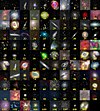NGC 6541
| Kugelsternhaufen NGC 6541 | |
|---|---|
 | |
| Hochaufgelöste Abbildung des Zentrums von NGC 6541 mithilfe des Hubble-Weltraumteleskops. | |
| AladinLite | |
| Sternbild | Südliche Krone |
| Position Äquinoktium: J2000.0, Epoche: J2000.0 | |
| Rektaszension | 18h 08m 02,3s [1] |
| Deklination | -43° 42′ 57″ [1] |
| Erscheinungsbild | |
| Konzentrationsklasse | III [2] |
| Helligkeit (visuell) | 6,3 mag [3] |
| Winkelausdehnung | 15,0' [3] |
| Physikalische Daten | |
| Radialgeschwindigkeit | -153,8 km/s [4] |
| Entfernung | 22,8 kLj |
| Geschichte | |
| Entdeckung | Niccolò Cacciatore |
| Entdeckungsdatum | 19. März 1826 |
| Katalogbezeichnungen | |
| NGC 6541 • C 1804-437 • GCl 86 • ESO 280-SC4 • Dun 473 • GC 4372 • Bennett 104, Caldwell 78, h 3726 | |
NGC 6541 ist ein Kugelsternhaufen im Sternbild Südliche Krone.
Der Kugelsternhaufen NGC 6541 wurde am 19. März 1826 von dem Astronomen Niccolò Cacciatore entdeckt.[5]
Einzelnachweise
Auf dieser Seite verwendete Medien
Autor/Urheber: Roberto Mura, Lizenz: CC BY-SA 3.0
Caldwell Catalogue objects.
Autor/Urheber: NASA Hubble Space Telescope, Lizenz: CC BY 2.0
The globular star cluster Caldwell 78, also known as NGC 6541, was first observed in the year 1826. The Italian astronomer Niccolò Cacciatore and the Scottish astronomer James Dunlop discovered the cluster independently within just a few months of each other.
Caldwell 78 is best observed from equatorial latitudes in the Northern Hemisphere during the summer and from the Southern Hemisphere during the winter. The cluster has an apparent magnitude of 6.3 and is located in the constellation Corona Australis, roughly 22,000 light-years from Earth. The cluster can be spotted with binoculars, but will dazzle in a small telescope. A larger telescope will resolve some of the cluster’s individual stars.
Traditionally, astronomers believed that globular clusters were made up of stars that have both similar ages and similar chemical abundances. However, recent studies suggest that this simplistic view is not always true. It seems as though many globular clusters contain stars with different chemical abundances relative to one another (or “multiple populations”), suggesting the stars formed at different times.
This image of Caldwell 78 is a composite of observations taken in visible and ultraviolet light by Hubble’s Wide Field Camera 3. These observations were made to better characterize the cluster’s stellar populations.
Credit: NASA, ESA, and G. Piotto (Università degli Studi di Padova); Processing: Gladys Kober (NASA/Catholic University of America)
For Hubble's Caldwell catalog website and information on how to find these objects in the night sky, visit: <a href="https://www.nasa.gov/content/goddard/hubble-s-caldwell-catalog" rel="noreferrer nofollow">www.nasa.gov/content/goddard/hubble-s-caldwell-catalog</a>

